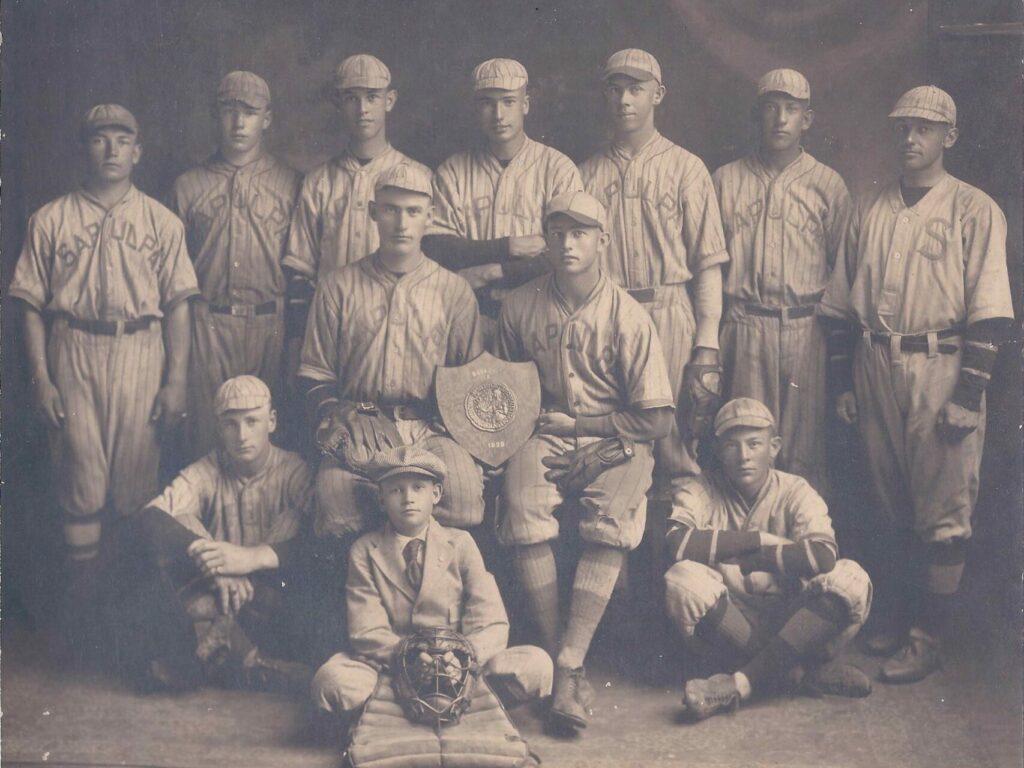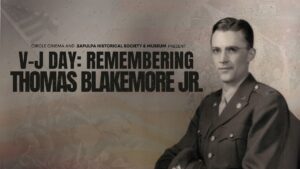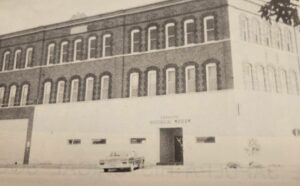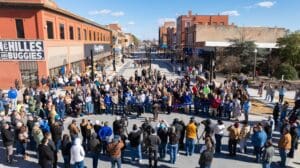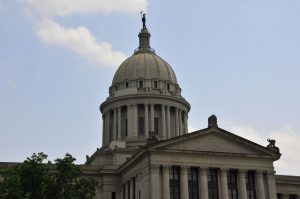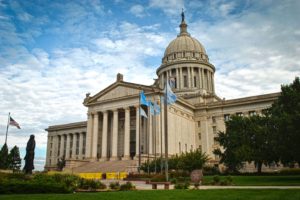Rachel Whitney, Curator,
Sapulpa Historical Museum
“That boy Denver Grigsby seems to be knocking ‘em a mile high.” This was not an uncommon phrase when describing Grigsby’s turn at bat. From the home plate to the outfield and beyond, from High School Championships to Major League diamonds, Grigsby played with some of baseball’s best.

On March 24, 1901, Denver was born in Kentucky. The Grigsby family moved to Sapulpa when Denver was six, just before Oklahoma statehood, in 1907. He and his siblings made many new friends and became a part of Sapulpa and its history.
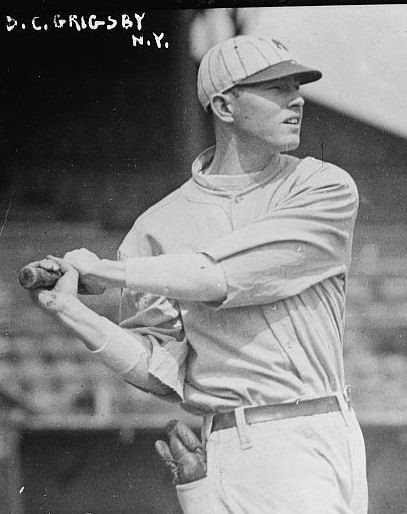
Denver would graduate from Sapulpa High School in 1921, alongside Frances Hutt, the opera singer and nearly-First-Lady-of-the-United-States we wrote about a couple of weeks ago. As Hutt made news about her singing and performances while at the High School, Grigsby made a splash in the news for his performances on the diamond.
In high school, Denver was the pitcher on the mound. Not only could he throw, but he could also bat, too. In the Sapulpa Herald, Babe Ruth was given a nickname of “king of the swing” and the “mighty swat artist.” Other nicknames George Herman “Babe” Ruth were the “the Great Bambino” and the “Sultan of Swat.” Grigsby was often compared to some of the greats in baseball when it came to home runs.
Sapulpa High School Sappers, then before being renamed the Outlaws, before being renamed Chieftains, came home as baseball champions in 1920 and 1921. “By winning four straight games, one of which was a thirteen-inning game, the Sapulpa High School ball team is coming home tonight the champion team of the great new state of Oklahoma. Shawnee, Norman, Miami, and Nowata went down to defeat at the hands of the locals…Sapulpa was ready to come home with the bacon.
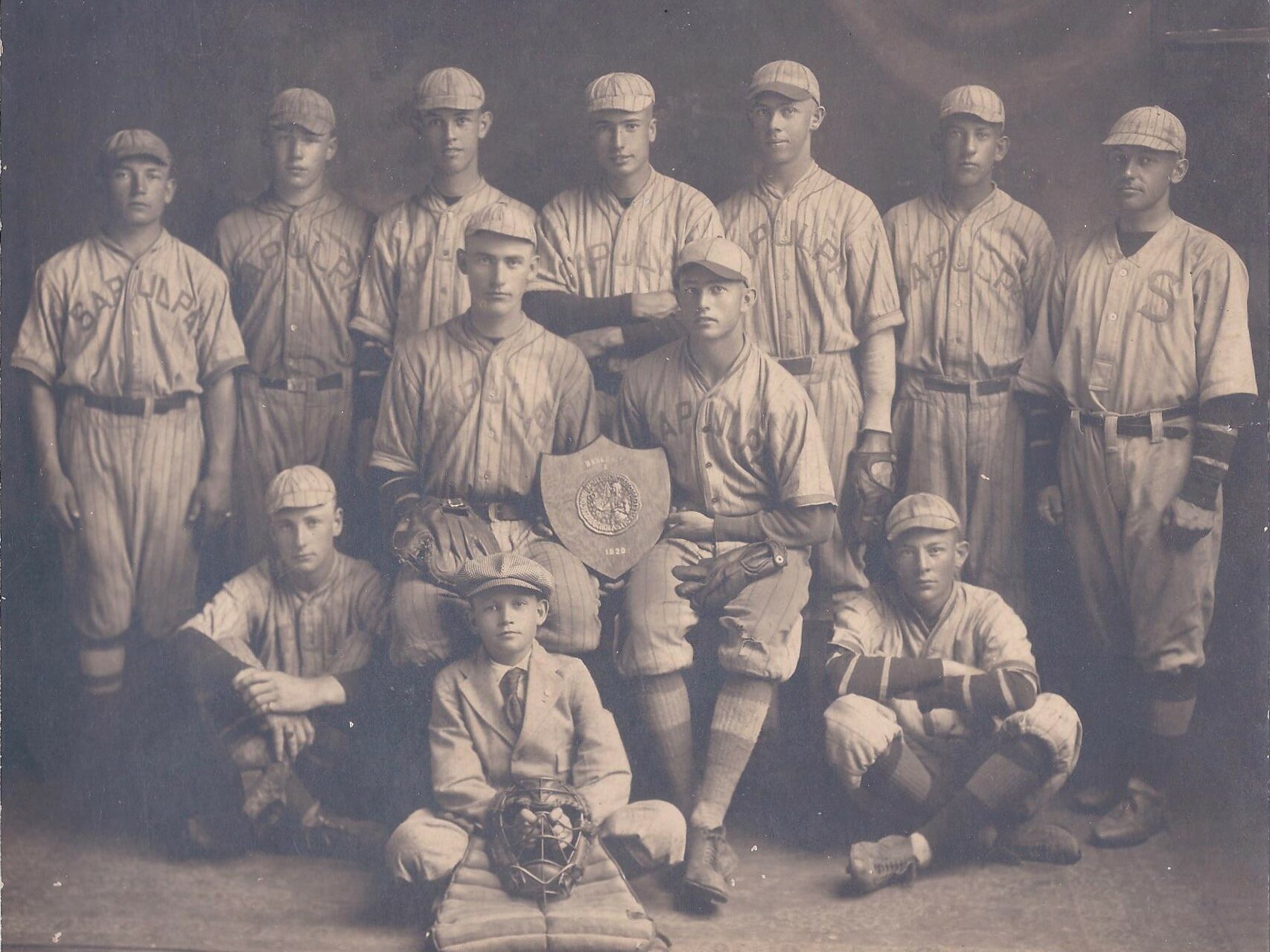
“Grigsby starred pitched throughout the series, having pitched the Miami and Nowata games besides otherwise making himself famous.” The Sappers were acknowledged as one of the best teams in high school baseball.
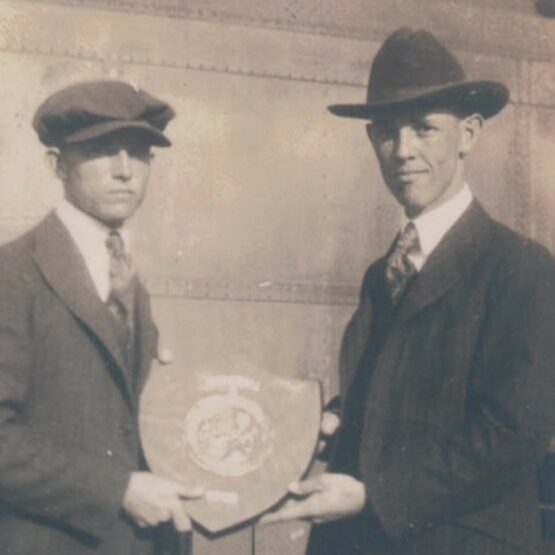
These great games and the extraordinarily versatile player of Denver Grigsby caught the attention of the New York Yankees. At the end of 1921, Grigsby signed on to play for New York. At the time, Babe Ruth was being transferred from Boston Red Sox to New York Yankees during the 1919-1920 seasons. Grigsby would’ve played alongside one of the best home run hitters of all time.
However, he went to spring training with the Yanks in New Orleans. He was converted from a pitcher to an outfielder, and competed for an outfield position against Babe Ruth and others. He was farmed out to Albany, NY in the Eastern League. He later went to Sioux City, Iowa in the Western League. The town of Sapulpa also had their own Minor League team, the Sapulpa Yanks.
Grigsby came back to Sapulpa and played his heart out to earn the spot in the Major Leagues. “Denver Grigsby sets a new home run record. Boy! Page Babe Ruth, Ken Williams, Home Run Baker, and all the mighty swat artists. Then tell ‘em this story: Denver Grigsby, an outfielder with Sapulpa Yanks, smashed all the present-day home run records in the major leagues and tied the world’s record hung up since the first organized baseball game when he knocked four home runs yesterday!”

Grigsby was immediately “gobbled up” by the Chicago Cubs after receiving word on the great batter. “Denver Grigsby, Sapulpa’s offering to the major leagues, has won his berth in the outfield with Killefer’s Chicago Cubs, National League aggregation.” He would be flown out to California for the Cubs training in February 1923.
This week in Sapulpa history, while training in California in 1923, Denver turned twenty-two. He was praised by the Cubs. “Denver Grisby, who will soon reach the age of 22, is one of the most promising young outfielders in Killefer’s roster of recruits.” Grisby threw right-handed, and batted left, and was said to be “one shining light.” “That young man is right-handed and he has plenty of power back of his cast. Denver throws low and he paints speed on his throws. Grisbsy is proving the most apt pupil. Grigsby is fast and rangy and stands well at the plate. He bats left-handed and hits the ball hard. Thus far he has displayed no weakness against pitchers.”
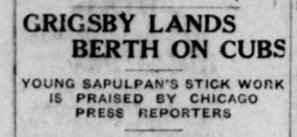
His contract stated he would earn $400 per month for his services*. He earned three seasons with the Chicago Cubs. In 1924, Grigsby was a starter. “Grigsby had a respectable career batting average of 2.89 with an on base percentage of .355 over a period of 199 MLB games.” He also had 73 RBI, 179 hits, and had 3 home runs during his time in the Major Leagues**.
*Note: in 1924, the earnings of $400 per month (or $4,800 a year) is nearly $7,000 a month (or $84,000 a year) in today’s inflation.
**Note: there have been debates about Denver Grigsby being awarded the Rookie of the Year in 1924. The actual award for Rookie of the Year didn’t begin until Jackie Robinson of the Brooklyn Dodgers in 1947. The Most Valuable Player in 1924 went to Babe Ruth of the New York Yankees. However, there was an article after Grigsby’s death about Grigsby being Chicago Cubs’, clubhouse Rookie of the Year. However, on the Baseball Reference website is the only place that mentions the status of the 1924 rookie award. The website states: “exceeded rookie limits during the 1924 season.” This does not prove nor disprove the claim of Rookie of the Year for Grigsby.
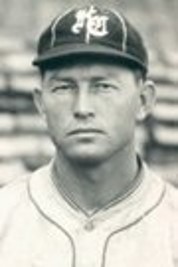
Sadly, in the middle of the season in 1925, Grigsby broke his collarbone. He was out for the rest of the season. He was then sold to the Minor Leagues for the Kansas City Blues. He played for the Blues for eight seasons.
While playing ball, Grigsby lived off and on in Sapulpa. He even surprised the town with a wedding and marriage to a local woman, Louise Coley. “The romance of the pair dating back to the days of ‘readin’, writin’, and ‘rithmetic.’” The news broke out about their marriage almost a full month after their ceremony. After the surprising announcement, friends of the newlyweds threw a party. “In recognition of Mr. Grigsby’s popularity among baseball fans the predominant motifs used in the decorations were baseball gloves, mitts, bats, and masks.”

Grigsby was selected to the All Star Team on two different occasions while with the Blues. He then went to Montreal in 1934. The following season he played for Tulsa in the Texas League. His baseball career ended in 1935.
He and Louise settled down in Sapulpa, and made home at 223 N Linden. Denver leased the Skelly Service Station at 517-519 E Dewey before purchasing the lot and naming it the Grigsby’s Skelly Service Station. Grigsby retired from the station service in 1972.
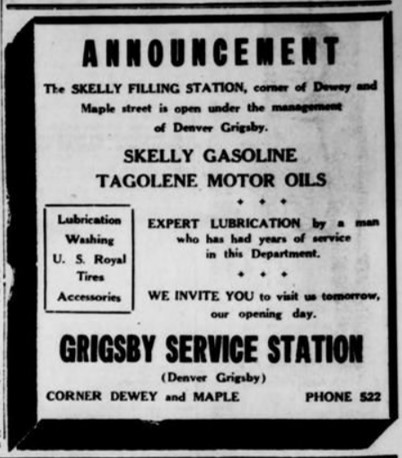
Denver Grigsby passed away on November 10, 1973 at Bartlett Memorial Hospital.
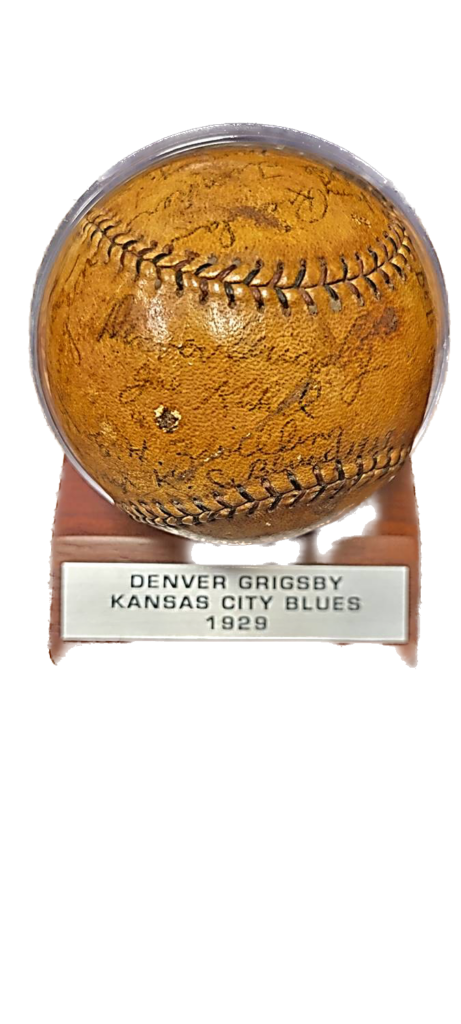
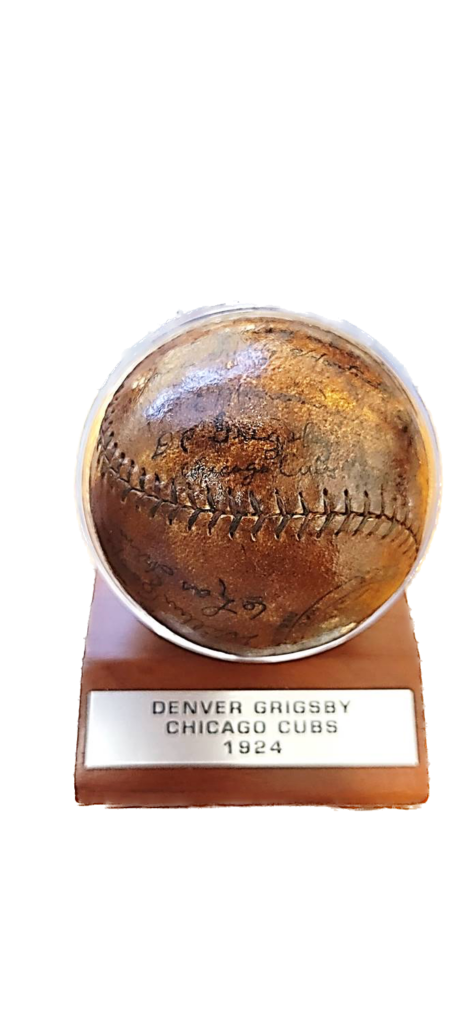
These baseballs signed by Denver Grigsby and his teams in 1924 and 1929 can be seen in the Sapulpa Historical Society Museum.
(Sources: Sapulpa Herald, May 1, 1920, May 26, 1922, May 29, 1922, January 10, 1923, February 16, 1923, March 10, 1923, March 15, 1923, March 17, 1923, March 22, 1923, March 31, 1923, April 5, 1923, April 7, 1923, April 10, 1923, July 7, 1923, February 26, 1924, April 5, 1924, May 7, 1924, October 10, 1924, January 14, 1925, January 20, 1925, January 29, 1925, February 27, 1925, March 25, 1925, March 28, 1925, May 1, 1936, November 12, 1973, March 28, 1982, July 30, 1995, August 20, 1995, July 2, 1998, July 8, 2007; Wikipedia; www.sportsillustrated.com; www.baseballrefrence.com; www.mlb.com; www.ainsworthsports.com; www.thisgreatgame.com; www.baseballcube.com; www.baseballalmanac.com)

